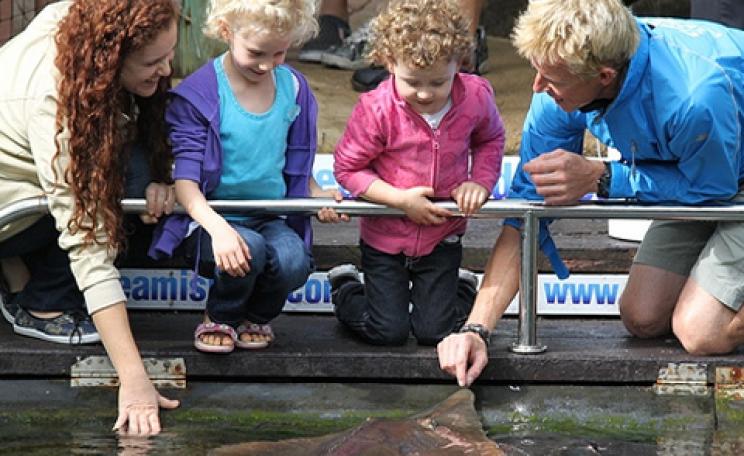Occasionally, parents have to collect their children early from a primary school near the alumina refinery because of white dust blowing into the schoolyard.
Industrial change has accelerated in Gladstone since the early 2000s. Three plants for the liquefaction and storage of coal seam gas have been built on Curtis Island near the city. Ground was cleared and pipelines stretched several hundred kilometres to transport the gas from the interior of the State.
Read Part I now!
Simultaneously, a new coal terminal was built at Wiggins Island just north of the city, increasing the port capacity considerably. To enable access for large ships, the western, shallower parts of Gladstone harbour were dredged from 2011 to 2013, removing 36 million cubic metres of sediment in the process.
The ownership structure of Gladstone’s large industrial operations is complex, and the LNG facilities are no exception.
Ownership and obfuscation
Although the Gladstone Ports Corporation is state-owned, the projects are owned by consortiums consisting of several companies with a complex and transnational ownership structure.
The LNG plants were built by the American corporation Bechtel, but the three plants are owned and operated by others. One is owned by QCLNG (Queensland Liquid Natural Gas), which in turn is owned by BG (British Gas).
Another is jointly owned by the Australian energy company Santos and the Malaysian company Petronas. The third project, Australia Pacific LNG, is operated jointly by the Australian company Origin, the American company ConocoPhillips and the Chinese company Sinopec.
Occasionally, parents have to collect their children early from a primary school near the alumina refinery because of white dust blowing into the schoolyard.
Many subcontractors have, moreover, been involved in various stages of the construction of pipelines and the plant itself, from large engineering companies to small, local actors like a transport company which moved trucks by boat from the mainland to the island and back.
When something goes wrong, it is therefore not always easy to identify who or what to blame and what to do.
Sacrificial lamb
Loyalty to industry remains strong, but it has been weakened in recent years. There is a broadly shared indignation over the large corporations' failure to engage in a direct and sustained way with the local community.
Many claim that Gladstone has received far too little in return for allowing large-scale industrial developments. One went so far as to describe the city as “the sacrificial lamb of Queensland. If it is noisy and dirty, just put it here.”
Locals argue that the city produces considerable wealth for south-eastern Queensland - the Brisbane and Gold Coast area - and gets little in return.
On the other hand, my research found that the ambivalence towards the double bind between fossil fuel-powered growth and ecological sustainability was less widespread than anticipated.
Instead, I found a great concern with health issues related to emissions, discharges and working conditions in the industry, as well as conflicts over the status of particular forms of knowledge.
Conflicting knowledge
During my fieldwork, there was massive disagreement over the implications of dredging the harbour.
Fish and crab disease, dying seagrass and disappearing dolphins effectively brought the Gladstone fishermen out of business, but the relevant causes and effects were vigorously disputed.
Interestingly, it was not merely a matter of technical, scientific knowledge conflicting with experiential knowledge. The scientists disagreed among themselves, as did the people basing their conclusions on their own experiences.
Many of the people I met still trusted science, but could no longer trust scientists until they knew who paid for their research.
Seeds of change
Another case concerns a simmering, long-term conflict over groundwater and mining in the agricultural township of Mount Larcom just west of Gladstone.
While mining executives and their scientists insisted that the large amounts of water pumped out of the limestone mine did not affect the groundwater, the farmers drew on various sources of knowledge, including scientific models, to counter this view.
This very distrust of established knowledge contains the seeds of citizen action and social change. Questioning authorities in this kind of setting can be empowering, in that non-elite people propose different interpretations that lead to alternative courses of action.
The anti-elitism witnessed in politics around Europe and North America these days is born of a related impulse, namely the conviction that people are being lied to, and that the power elites conceal important facts from them.
These and other examples are described in detail in my book Boomtown: Runaway Globalisation on the Queensland Coast (Pluto Press 2018).
Inevitable shocks
A difference with the Gladstone case is that the outrage there is directed at big money and the complicity between government and corporations, while the new populisms in Europe are strangely quiet when it comes to financial power.
In the Gladstone region, the city itself and its surrounding rural and semi-urban communities have been affected by growth and change in many ways.
Occasionally, parents have to collect their children early from a primary school near the alumina refinery because of white dust blowing into the schoolyard. Fishing and crabbing in the harbour is now out of the question.
The discovery of a colony of non-endemic fire ants, presumably from the USA, at an industrial site in late 2013, raised a few eyebrows, but nobody was deeply surprised. The population of Gladstone is accustomed to living with vulnerabilities resulting from industrial operations.
When I took part in a Conservation Volunteers Australia project to clear an oceanic beach of rubbish, and we came across Chinese and Korean water bottles, a Japanese Pepsi can and an empty juice carton from Cyprus, nobody was surprised. After all, the foreign cargo ships were visible on the horizon.
Fundamental contradictions
The recent, accelerated change in Gladstone – dredging, LNG plants, new coal terminal, expanding limestone mine – is contingent on Australia's integration into a changing global economy, a key factor being the growing global demand for minerals.
Scarcely anyone in Gladstone is against coal mining or industrialisation per se, perhaps because they are all entangled, but perhaps also because they see the difficulty of promoting a credible alternative. However, many do argue that local needs and community interests should be given first priority.
Two highly visible contradictions have led to a series of local tensions: the double bind between growth and sustainability, and the disjuncture between small-scale community concerns and large-scale corporate interests. These fundamental contradictions are the direct result of accelerated growth in a neoliberal world economy.
These are, at an abstract level, the major contradictions of contemporary globalisation. As this competition between knowledge regimes morphs into an unequal power relationship, the credibility of particular facts, interpretations and lived experiences become irrelevant.
Big money always has its way in the end. Yet, this very situation reveals a crisis of legitimacy which may foment collective action and demands for change.
This Author
Thomas Hylland Eriksen is a professor of social anthropology at the University of Oslo. He is the author of Boomtown: Runaway Globalisation on the Queensland Coast (Pluto 2018).




